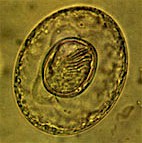Raillietina is a genus of parasitic tapeworms that has chicken, turkey, geese and numerous other domestic and wild birds as final hosts. It is found worldwide. It is quite common in traditional and free-ranging poultry.
Out of the 37 different species there are several species of veterinary importance with a different geographical distribution.
The most relevant ones are:

- Raillietina cesticillus, the broad-headed tapeworm, up to 13 cm long and 1-3 mm wide, in chicken, turkey and many wild birds; found worldwide
- Raillietina echinobothrida, the nodular tapeworm, up to 25 cm long and 1 -4 mm wide, in chicken, pigeon, pheasants; found worldwide
- Raillietina tetragona up to 25 cm long and 1-4 mm wide, in numerous domestic and wild birds; found worldwide
- Raillietina bonini up to 7 cm long and 1.5 mm wide, mainly in pigeons; found in Europe, Near and Middle East
These Raillietina species do not affect dogs, cats, cattle, sheep, pigs, horses and other mammals. There are some Raillietina species that can infect humans (e.g. R. demerariensis, R. asiatica, and R. formosana).
Are birds infected with Raillietina tapeworms contagious for humans?
NO. The reason is that these Raillietina tapeworms are not human parasites.
You can find additional information in this site on the general biology of parasitic worms and/or tapeworms.
Final location of Raillietina spp
The predilection site of adult Raillietina tapeworms is the small intestine.
Anatomy of Raillietina spp

Raillietina adults are whitish, medium-sized tapeworms 5 to 30 cm long and 1 to 4 mm wide, depending on the species. The head (scolex) is armed with numerous hooks, spines and 4 suckers to attach to the wall of the host's gut. The segments (proglottids) are wider than long. Each segment has its own reproductive organs of both sexes (i.e. they are hermaphroditic). Each segment has also excretory cells known as flame cells (protonephridia).
The reproductive organs in each segment have a common opening called the genital pore. In young segments all these organs are still rudimentary. They develop progressively, which increases the size of the segment as it is pushed towards the tail. The gravid terminal segments are barrel-shaped and are filled with eggs included in capsules.
Otherwise, as other tapeworms, they have neither a digestive tube, nor circulatory respiratory systems. They don't need them because each segment absorbs what it needs directly through its tegument.
The eggs measure ~75x95 micrometers. They are usually included in capsules inside the gravid segments. The number of capsules per gravid segment and of eggs inside each capsule is species-specific.
Life cycle and biology of Raillietina spp
All Raillietina species have indirect life cycles with domestic and wild birds as final hosts, and several insects (e.g houseflies, ants and beetles) or slugs and snails as intermediate hosts:
- Raillietina cesticillus: beetles
- Raillietina echinobothrida: ants
- Raillietina tetragona: ants and flies
- Raillietina bonini: slugs and snails
The gravid segments of adult tapeworms are shed with the birds' feces. They are motile and capable of climbing upwards on the vegetation. By mild and humid weather the eggs can remain infective for insects, slugs and snails during several days.
The intermediate hosts ingest the gravid segments, which release the eggs in their gut after digestion. The eggs then develop to cysticercoids in the body cavity of the intermediate hosts. The birds ingest such contaminated insects or mollusks. After digestion, the cysticercoids release the young tapeworms that attach to the wall of the bird's gut.
The time between infection and shedding of the first eggs (prepatent period) is 2 to 3 weeks.
Harm caused, symptoms and diagnosis
No Raillietina species is highly harmful for poultry. Light and medium infections remain usually without clinical signs, although weight gains and egg-laying performance can be lower than expected. As a general rule, young birds are more likely to suffer from such infections. Raillietina echinobothrida can cause the appearance of quite large nodules in the gut, but fatalities are uncommon. Heavy chronic infections may cause diarrhea, anemia, weight loss, and intestinal inflammation and hemorrhage.
As a general rule, free-ranging and traditionally kept poultry are more likely to become infected. However, flies, ants, and beetles can also contaminate the bedding or the feed in indoor poultry production.
Some bird species develop natural resistance to Raillietina infections, particularly turkey.
Diagnosis is usually done post-mortem upon autopsy. A representative number of birds should be checked and examination should include microscopy of mucosal scrappings to detect smaller related tapeworm species (e.g. Davainea proglottina). Gravid segments can also be detected in the feces of infected birds, but usually not the eggs.
Prevention and control of Raillietina
Measures to avoid that the feed becomes contaminated with ants or beetles are advisable. For the same reason fly control is also recommended. However, for both economic and ecologic reasons the use of insecticides against ants and beetles outdoors is not justified.
Where the slugs and snails are involved as intermediate hosts, frequent change of the birds' bedding and keeping it dry can help to avoid infections because it shortens the survival of the eggs and is unattractive for slugs and snails. Free-ranging birds should be kept off humid environments that are supportive of slugs and snails.
Chemical control of the snails and slugs with molluscicides (i.e. snail killers) such as copper sulphate, sodium pentachlorophenate, niclosamide, etc. is not advisable. It is virtually impossible to treat every place where they can survive and they reproduce extremely quickly. Cleaned pastures would become re-infested very fast. In addition it would be also very harmful for the environment. In fact, such molluscicides (mainly niclosamide) are approved only in a few countries as an aid in the prevention of human schistosomiasis (also called bilharziosis or snail fever).
Flocks at risk can be treated with anthelmintics effective against tapeworms. They contain either broad-spectrum benzimidazoles (e.g. albendazole, febantel, fenbendazole, mebendazole, oxfendazole, etc.) or specific taenicides (e.g., niclosamide, praziquantel, etc.). Most of these active ingredients are available as additives for feed or drinking water, or as tablets for oral delivery.
WARNING: niclosamide is toxic for geese, and the combination of praziquantel with pyrantel tartrate is toxic for chicken!
Other classic livestock anthelmintics such as macrocyclic lactones (e.g. ivermectin, doramectin, moxidectin, etc.), levamisole, tetrahydropyrimidines (e.g. pyrantel, morantel) and piperazine derivatives are not effective at all against Raillietina or whatever tapeworm.
There are so far no vaccines against Raillietina. To learn more about vaccines against parasites of livestock and pets click here.
Biological control of Raillietina tapeworms (i.e. using its natural enemies) is so far not feasible.
You may be interested in an article in this site on medicinal plants against external and internal parasites.
Resistanceof Raillietina spp to anthelmintics
So far there are no reports on resistance of Raillietina tapeworms to anthelmintics.
This means that if an anthelmintic fails to achieve the expected efficacy, chance is very high that either the product was unsuited for the control of
|
Ask your veterinary doctor! If available, follow more specific national or regional recommendations for Raillietina control. |